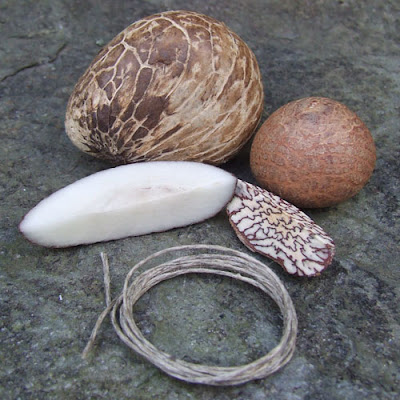As well as selling organic craft materials ideal for making dreamcatchers, we also create a few ourselves and have recently been crafting a wide variety of styles and sizes using only organic materials. This blog illustrates the different stages for making the dreamcatcher shown in the above photo.
We supply three different sizes of cane rings and will expand the size ranges for our 2013 stock. I recommend cane rings as they are light and sturdy, but a dreamcatcher could be made out of almost any roughly circular ring. The beads I have chosen to use are ritha seeds, these are the hard seeds found in the centre of soapnuts.
If you have produced a ring from willow or any other naturally attractive material, perhaps you would wish to leave it bare. I have chosen to cover the this cane ring with wild Himalayan handspun hemp that we have dyed using traditional natural dyes. I prefer to coat the twine with beeswax by gently flossing the twine through a block of wax, this is purely optional. Other materials we often use from our selection for this purpose are wool, blended hempwool yarns and nettle twine.

The use of beads helps add a personal touch to dreamcatchers and needs to be decided prior to threading. The above image shows how the initial pass of the thread around the ring is attached after being tied at your starting point. As you can see, I have added beads into the initial pass, although usually I tend to add beads at a slightly later stage of threading. This method of attaching the twine (in this case 4 ply giant Himalayan nettle) is all that is required to complete the web. The second and subsequent passes no longer wrap around the cane, but around the twine of the previous pass.

With this dreamcatcher, I decided to incorporate a smaller cane ring into the centre and have wrapped this smaller ring with hemp in exactly the same way as the larger ring. After several passes on the larger ring, I added some more beads and then one more pass running through the beads to tighten everything off. For a larger web I would have just continued threading the beeswax coated nettle until I reached the centre. It is important to maintain a nice even tension otherwise your ring can be pulled slightly out of shape if too tight or alternatively result in a loose web if lacking in tension.

The next step is a little more unusual as I planned on weaving a yarn into the dreamcatcher as opposed to just a plain web. To weave the weft yarn I need a firm warp thread to weave around. I secured the smaller ring in the centre using a temporary thread and then used the original nettle twine to create a permanent fix (and warp threads) between the small ring and the beads. Again, an equal tension is vital. The photo below shows the dreamcatcher ready for the weaving stage.
In keeping with the three colours of the hemp twine used to cover the ring, I have selected blended hempwool yarns dyed with the same natural dyes to complete the weaving. This stage is a little time consuming, but not too difficult and you can easily change yarn colours.
The image below shows the dreamcatcher in an almost finished state with all knots tied off and loose ends trimmed. It was for purely aesthetical reasons that I broke the weaving sections up into to three segments. I could have been possible to weave a continues circle or indeed a dreamcatcher comprising of just weaving.

Not shown in any photographs is the hemp twine used to craft the hanging loop. I used hemp of the same three colours that were waxed and then twisted together to make a thicker twine. Instead of the traditional use of feathers, I chose to craft tassels from the blended hempwool, wooden beads and then attached using the nettle twine. The number and length of tassels is entirely upto you, as are pretty much all of the choices made in crafting a dreamcatcher. I understand that this is not a traditional looking dreamcatcher and maybe not suitable for your first go at making one, but it should hopefully help inspire anyone to have a go and be experimental. As with most crafts, imagination is the bulk of the recipe with a dash of patience and craft skill.
All of the materials used for this dreamcatcher and a wide range of other organic materials are available from our online store and can be shipped worldwide.
As always, enquiries and general queries are always welcome. We can be contacted through our contact link on our homepage which can be reached by the link below.




















